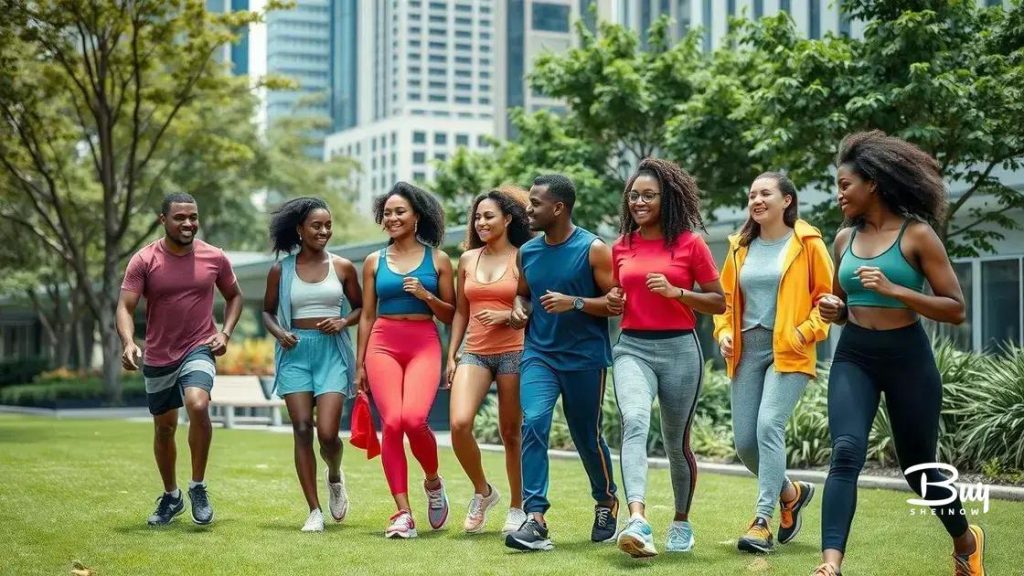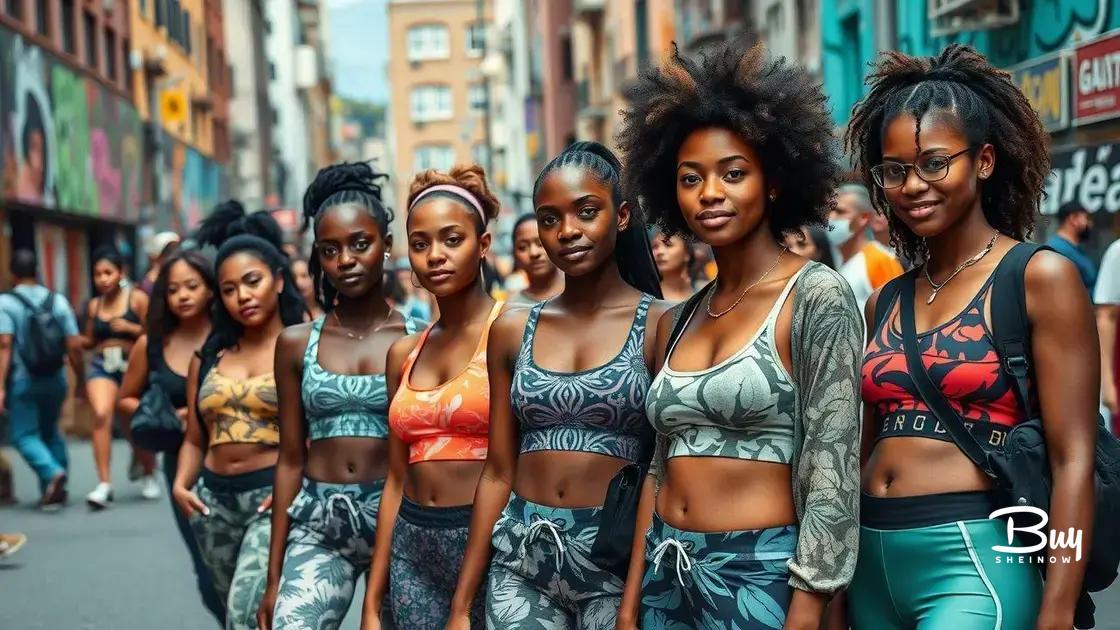Athleisure 2.0: What’s trending in activewear

Athleisure 2.0 combines style and functionality, utilizing advanced materials and sustainable practices, making it a preferred choice for both fitness and everyday wear.
Athleisure 2.0 is quickly becoming the go-to choice for those who want to blend comfort with style. But what exactly is driving this trend? Let’s dive into the vibrant world of modern activewear and uncover what’s making waves.
Defining athleisure 2.0
Athleisure 2.0 represents a new era in activewear, characterized by a seamless blend of style and functionality. With the rise of this trend, many individuals seek to wear clothing that not only performs well during workouts but also looks fashionable in everyday settings.
So, what exactly defines this new wave of athleisure? Let’s explore some key aspects that set athleisure 2.0 apart from its predecessors.
Key Characteristics
One of the defining features of athleisure 2.0 is its focus on versatility. This means that clothing items can transition easily from the gym to casual social settings. Styles are becoming more innovative, incorporating elements that enhance both comfort and aesthetics.
- High-performance materials that wick moisture
- Stylish designs suitable for both workouts and outings
- Inclusivity in sizing and fit for diverse body types
- Eco-friendly options made from sustainable fabrics
Furthermore, athleisure 2.0 embraces a less rigid approach to fashion. Instead of sticking to traditional athletic silhouettes, designers are experimenting with more relaxed cuts and unexpected pairings.
This flexibility opens the door for combining athleisure with everyday fashion staples. Imagine pairing sleek leggings with a tailored blazer or wearing sports bras under chic outerwear. These combinations reflect a contemporary lifestyle that values both ease and style.
The Influence of Technology
Technology also plays a crucial role in the evolution of athleisure 2.0. Innovations in fabric technology have led to the development of materials that offer advanced features such as breathability, temperature regulation, and UV protection. Such advancements ensure that wearers stay comfortable, no matter the activity.
By understanding the fundamentals of athleisure 2.0, you can make more informed choices about your activewear. The next time you shop, consider not just how an outfit performs during your workout, but how well it integrates into your daily life.
Key materials driving activewear fashion
In the world of activewear fashion, the choice of materials greatly influences both performance and style. The latest trends show a shift towards fabrics that are not only functional but also fashionable.
Many activewear brands are now focusing on high-performance materials that boost comfort while ensuring style. These innovations cater to the needs of modern consumers who demand both functionality and aesthetics in their clothing.
Popular Materials
Several key materials are driving the evolution of activewear. Here are some of the most commonly used:
- Moisture-wicking fabrics: These materials pull sweat away from the skin, keeping you dry during workouts.
- Spandex: This elastic fiber allows garments to stretch while providing a snug fit, enhancing comfort and mobility.
- Breathable mesh: Often used for panels, mesh allows air circulation, keeping you cool.
- Recycled polyester: As sustainability becomes a priority, brands are opting for recycled materials that reduce environmental impact.
Eco-friendly fabrics are also making waves in activewear. Consumers are increasingly concerned about sustainability, which pushes brands to innovate in this area. By using organic cotton or recycled materials, brands can offer environmentally friendly options that appeal to eco-conscious shoppers.
Moreover, many companies are developing textiles that offer added functionalities. Some fabrics include built-in UV protection, while others are designed to enhance recovery post-workout by increasing blood flow. These advancements showcase how material selection directly impacts performance.
Furthermore, the aesthetic appeal of these materials is just as important. Consumers look for colors and designs that reflect their personal style. Therefore, the challenge for designers is to balance functionality with eye-catching visuals.
As you consider your next activewear purchase, keep an eye on the materials used. Understanding the benefits of various fabrics can help you choose clothing that performs well and looks great.
Top trends to watch this season

This season, activewear fashion is set to showcase some exciting trends that blend functionality with style. Fashion enthusiasts and fitness buffs alike should keep an eye on these top trends to stay ahead in their wardrobe choices.
One significant trend is the emphasis on versatile layering. As temperatures fluctuate, layering allows wearers to adapt their outfits for different activities and environments. Think about stylish vests over tank tops or lightweight jackets that can easily be tied around the waist.
Biggest Trends
Here are some of the standout trends to look for this season:
- Bold Prints: Bright colors and bold patterns are making a statement. Look for geometric designs and vibrant hues that add energy to your look.
- High-Waisted Leggings: These provide comfort and support for workouts while being flattering and fashionable for everyday wear.
- Cropped Tops: Perfect for pairing with high-waisted bottoms, cropped tops offer a trendy twist, making them popular among activewear enthusiasts.
- Sustainable Choices: Eco-conscious consumers are gravitating towards brands that prioritize sustainability, making recycled materials a hot trend.
Furthermore, gender-neutral activewear is gaining popularity. More brands are releasing collections that are designed to be inclusive, breaking away from traditional gender norms. This trend opens up more options for individuals who prefer a more fluid wardrobe.
The influence of streetwear on activewear is another notable trend. Combining sporty pieces with casual street styles creates a fresh, modern aesthetic that resonates with younger audiences. Expect to see joggers paired with stylish sneakers and crop hoodies for an effortless look.
Beyond aesthetics, functionality remains key. Features like moisture-wicking fabrics and enhanced breathability ensure that pieces are not only stylish but also practical for movement. As such, the focus on comfort does not compromise the style factor.
How to style athleisure for everyday wear
Styling athleisure for everyday wear is easier than you might think. The key is to create outfits that blend comfort and style while ensuring you feel confident.
One popular approach is to pair high-waisted leggings with an oversized, cozy sweater. This combination provides both comfort and a trendy look. Add a pair of stylish sneakers to complete the outfit. Not only will you look great, but you will also be ready for any activity.
Layering Techniques
Layering is a great way to elevate your athleisure look. For example, a fitted tank top under a relaxed-fit jacket can add depth to your outfit. As the weather changes, you can easily adjust by removing layers. This versatility allows you to adapt to different settings and temperatures.
- Mix and Match: Combine different textures and fabrics. Pair soft joggers with a denim jacket for a stylish contrast.
- Accessorize Wisely: Use accessories like a sleek crossbody bag or a sporty cap to enhance your look.
- Color Coordination: Choose colors that complement each other. Keep it simple, or play with bold colors for a more dynamic outfit.
Another trend is to wear athleisure pieces at work. For instance, pair tailored joggers with a chic blouse and loafers. This outfit blends professional and casual styles seamlessly, making it perfect for a modern workplace.
Additionally, don’t forget about footwear. Stylish trainers or slip-on shoes can elevate your outfit while keeping it comfortable. When you mix comfort with fashionable elements, you create a balanced ensemble.
To round off your look, consider wearing a statement piece like a trendy bomber jacket or a stylish backpack. These elements bring a finishing touch that can take your athleisure style from casual to chic.
The impact of sustainability on activewear
The impact of sustainability on activewear is significant and growing rapidly. As consumers become more aware of environmental issues, they seek products that reflect their values. This shift is driving brands to adopt eco-friendly practices and materials.
One major change in the industry is the use of recycled materials. Many activewear brands now incorporate fabrics made from recycled plastics, reducing waste and energy consumption. By using these materials, brands can help minimize their environmental footprint while still offering high-quality clothing.
Benefits of Sustainable Activewear
Sustainable activewear provides numerous advantages. Here are some key benefits:
- Eco-friendly Practices: Brands that prioritize sustainability often implement eco-friendly manufacturing processes, which can reduce water and energy usage.
- Better for the Planet: Choosing sustainable options helps decrease pollution and promotes responsible consumption.
- Healthier Choices: Many sustainable materials are free from harmful chemicals, making them safer for both wearers and the environment.
- Long-lasting Quality: Sustainable brands often focus on durability, providing products that last longer, which can save consumers money in the long run.
Additionally, brands are becoming more transparent about their supply chains. Shoppers want to know where their clothes come from and how they are made. By sharing this information, brands build trust and loyalty with their customers.
Sustainable fashion is not just a trend; it’s a crucial movement shaping the future of activewear. As innovations in eco-friendly technologies continue to emerge, we can expect even more exciting developments that prioritize style while caring for the planet.
As awareness grows, many consumers are also willing to invest in higher-priced sustainable items, understanding that these purchases support a healthier planet. This willingness reflects a shift in mindset towards valuing quality and responsibility over fast fashion.
In conclusion, the evolution of athleisure reflects a shift towards style, comfort, and sustainability. With bold designs, advanced materials, and a focus on eco-friendly practices, activewear is not just for workouts but has become a staple in everyday wardrobes. As consumers become more conscious of their choices, brands must continue to innovate and adapt, ensuring they meet both fashion and environmental standards. By embracing these trends, individuals can enjoy stylish outfits that also support a healthier planet.
FAQ – Frequently Asked Questions about Athleisure and Sustainability
What is athleisure?
Athleisure is a fashion trend that combines athletic wear with everyday clothing, allowing versatility and comfort.
How is sustainability impacting activewear?
Sustainability is leading brands to use eco-friendly materials and implement practices that reduce environmental impact.
What materials are commonly used in sustainable activewear?
Common materials include recycled plastics, organic cotton, and biodegradable fabrics, promoting eco-conscious choices.
How can I style athleisure for everyday wear?
You can style athleisure by mixing high-waisted leggings with oversized tops, layering with jackets, and accessorizing to fit various occasions.





